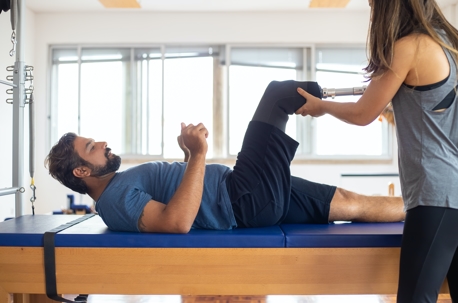IT Band Syndrome Part 4: Physical Therapy
Our Physical Therapists, in New York City, will do a complete history and physical assessment to determine the factors that are contributing to the pain. This will include:
- Range of motion of the whole lower part of your body – spine, hips, knees, and ankles/feet, looking at joint range of motion as well as the length of muscles
- Strength of core, hips, knees, ankles
- Functional movements – how you squat, walk, run, cycle, etc
- Special tests designed to confirm the diagnosis of IT band syndrome
Treatment:
- In the acute stage, the goal is to control inflammation.
- Rest from running/cycling, ice and/or other modalities, and gentle stretches.
- Anti-inflammatory medications as directed by your physician.
- At this time your physical therapist will also address other muscles/joints away from the painful site that was thought to be contributing to the biomechanical running/cycling fault. For example, a stiff ankle joint or weak core muscles.
- In the sub-acute stage, the goal is to continue to control inflammation but add exercise as tolerated
- Continue to address muscles/joints away from the painful site as discussed above
- Soft tissue mobilization (hands-on treatment) to the IT band and other tight muscles/tissues that are thought to be contributing to the problem
- Stretches to IT band and other tight hip, knee, or ankle muscles
- The addition of initial strengthening exercises based on the assessment of muscle strength. Often in IT band syndrome, the focus is on the Gluteus Medius and Maximus.
- In the final stage, the goal is to return to the desired activity (running/cycling)
- Continue stretching
- Strengthening exercises are progressed
- Functional exercises are added when pain-free such as squats, lunges, step-ups/down
- Progress to biomechanical training as able, correcting running or cycling form.
- Often runners and cyclists “work through” IT band syndrome pain for some time before seeking treatment. During this time, the runner or cyclist often starts to compensate for the pain. This can lead to altered biomechanics that also needs to be addressed during physical therapy treatment.
- If there is a leg length discrepancy, a small lift may be beneficial
- If there are altered foot mechanics, an orthotic or change in running shoe may be beneficial
- Education on previous training errors
All treatment is different and unique to the individual's needs so let our therapists at New York our location asses to determine the best course of treatment.
References:
Aderem J, Louw QA. Biomechanical risk factors associated with iliotibial band syndrome in runners: a systematic review. BMC Musculoskelet Disord. 2015;16:356. Published 2015 Nov 16. doi:10.1186/s12891-015-0808-7
Baker RL, Souza RB, Fredericson M. Iliotibial band syndrome: soft tissue and biomechanical factors in evaluation and treatment. PM R. 2011 Jun;3(6):550-61. doi: 10.1016/j.pmrj.2011.01.002. PMID: 21665168.
Ferber R, Noehren B, Hamill J, Davis IS. Competitive female runners with a history of iliotibial band syndrome demonstrate atypical hip and knee kinematics. J Orthop Sports Phys Ther. 2010 Feb;40(2):52-8. doi: 10.2519/jospt.2010.3028. PMID: 20118523.
Physical Therapy Guide to IT Band Syndrome , Choose PT website available at: https://www.choosept.com/symptomsconditionsdetail/physical-therapy-guide-to-iliotibial-band-syndrome-itbs

